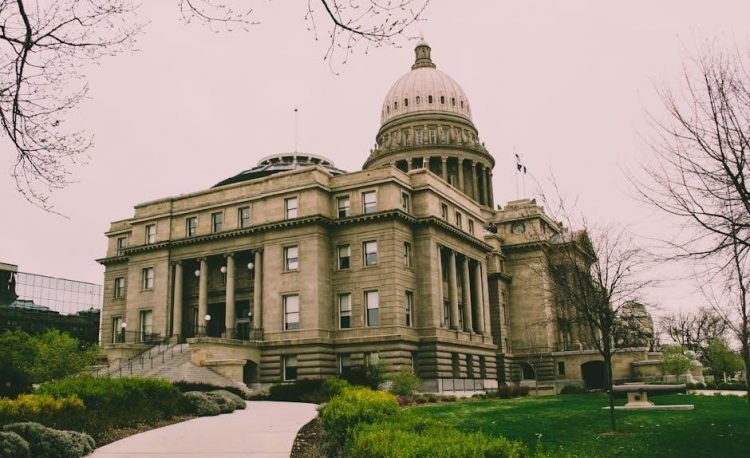The AMSCO U.S. Government and Politics PDF is a comprehensive guide designed to help students master the fundamentals of American governance, covering key concepts, institutions, and processes while fostering critical thinking and analysis.
Overview of the AMSCO U.S. Government and Politics PDF
The AMSCO U.S. Government and Politics PDF is a widely recognized study guide that provides a detailed exploration of the American political system. Designed for students preparing for exams or seeking a deeper understanding of governance, this resource covers foundational principles, institutions, and contemporary issues. It is structured to align with standard curriculum requirements, ensuring comprehensive coverage of topics such as the Constitution, federalism, civil liberties, and the electoral process. The guide is known for its clear explanations, concise summaries, and practical examples, making complex concepts accessible. Additionally, it includes review questions and practice exercises to reinforce learning. This PDF serves as an essential tool for anyone aiming to grasp the intricacies of U.S. government and politics, offering a balanced blend of theoretical knowledge and practical application.
Importance of Studying U.S. Government and Politics
Studying U.S. government and politics is essential for understanding the framework of American society, including the rights, responsibilities, and roles of citizens. It provides insights into how laws are created, enforced, and interpreted, shaping the daily lives of individuals. By examining the structure of government, students gain a deeper appreciation for the balance of power and the principles of democracy. This knowledge fosters critical thinking, civic engagement, and informed participation in the political process. Additionally, it equips individuals to analyze policies, evaluate their impacts, and contribute to meaningful discussions about governance. The AMSCO guide serves as a valuable resource for this educational journey, helping students build a strong foundation in these vital subjects.
Structure and Content of the AMSCO Guide
The AMSCO U.S. Government and Politics PDF is organized into a logical structure, ensuring a systematic approach to learning. It begins with foundational concepts, such as the Constitution and federalism, and progresses through detailed examinations of government branches, political participation, and civil rights. Each section is supported by clear explanations, relevant examples, and essential study resources. The guide includes chapter summaries, review questions, and key terms to reinforce understanding and retention. Its concise yet comprehensive format makes it an accessible tool for students seeking to grasp complex topics. By focusing on clarity and depth, the AMSCO guide provides a robust framework for mastering U.S. government and politics, making it invaluable for both independent study and classroom instruction.
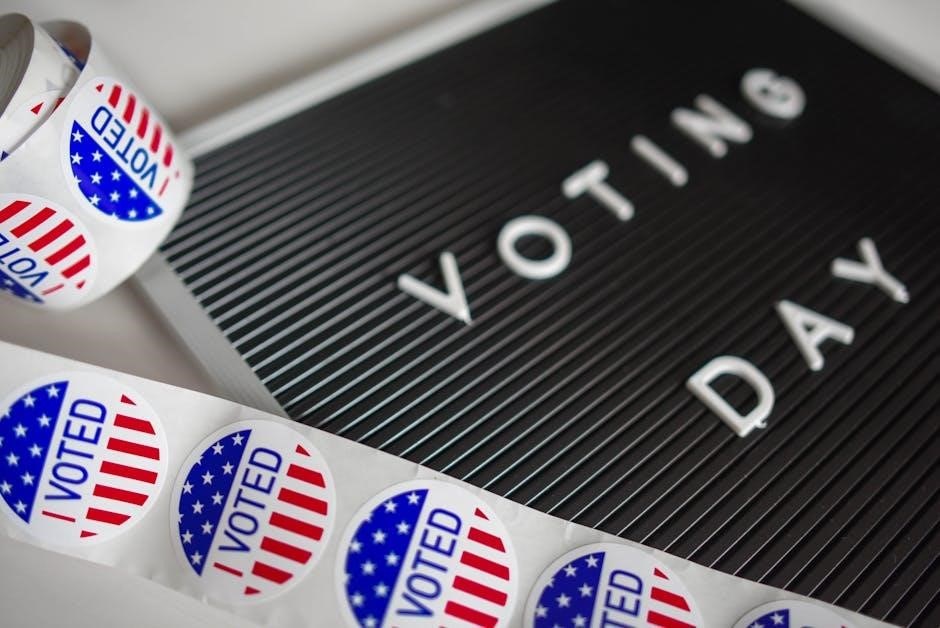
Foundational Concepts
Foundational concepts form the cornerstone of understanding U.S. government and politics, providing essential insights into the framework of American governance. They include the U.S. Constitution, federalism, the rule of law, and civil liberties, which collectively shape policies and rights.
The U.S. Constitution and Its Amendments
The U.S. Constitution is the foundation of the American legal and political system, outlining the structure of government and the rights of citizens. Ratified in 1788, it establishes the framework for federalism, the separation of powers, and checks and balances. The Preamble sets forth the Constitution’s purpose: to establish justice, ensure domestic tranquility, provide for the common defense, promote general welfare, and secure liberty. The Bill of Rights, comprising the first ten amendments, guarantees fundamental freedoms such as free speech, religion, and due process. Subsequent amendments address issues like abolishing slavery, granting voting rights, and expanding civil liberties. Understanding the Constitution and its amendments is crucial for analyzing U.S. governance, civil liberties, and policy-making.
Federalism: Division of Powers
Federalism is a cornerstone of the U.S. political system, dividing power between the federal government and state governments. The Constitution outlines this division, with the federal government responsible for national matters like foreign policy, defense, and interstate commerce, while states handle local issues such as education, transportation, and public safety. The Tenth Amendment reinforces state authority, reserving powers not delegated to the federal government to the states or the people. This system promotes balance, allowing for unified national policies while enabling states to address unique regional needs. Over time, the balance of power has evolved, with the federal government assuming more authority, particularly in areas like civil rights and economic regulation, while states maintain significant autonomy in governance and policy implementation.
The Rule of Law and Civil Liberties
The rule of law is a fundamental principle of the U.S. government, ensuring that all individuals and institutions, including the government itself, are subject to a set of established laws. This principle guarantees fairness, accountability, and consistency in the application of justice. Civil liberties, protected by the Constitution, particularly the Bill of Rights, safeguard individual freedoms such as speech, religion, and assembly. These liberties are essential for a functioning democracy, allowing citizens to express their beliefs and participate in the political process. The Constitution balances these liberties with the need for government authority, ensuring that individual rights are not infringed upon without due process. Landmark Supreme Court cases, such as Brown v. Board of Education, have played a crucial role in interpreting and expanding these protections, reinforcing the importance of the rule of law in maintaining a just society.

Government Branches
The U.S. government is divided into three branches: Legislative, Executive, and Judicial. Each branch has distinct roles and powers, ensuring a system of checks and balances.

The Legislative Branch: Congress and Its Functions
The legislative branch, composed of Congress, is a cornerstone of U.S. democracy, entrusted with making laws. It consists of two chambers: the Senate and the House of Representatives. Senators serve six-year terms, while representatives serve two years, with membership based on state population; Congress’s primary responsibilities include drafting, debating, and voting on legislation. It also approves the federal budget and exercises oversight of the executive branch through hearings and investigations. Additionally, Congress has the authority to declare war, regulate commerce, and approve or reject presidential appointments, including Supreme Court justices and cabinet members. This branch plays a critical role in balancing power and ensuring accountability within the federal government, while representing the interests of the American people. Its functions are essential to maintaining democratic governance and upholding the Constitution.
The Executive Branch: The President and Administration
The executive branch, led by the President, is responsible for enforcing federal laws and managing the government’s daily operations. The President serves as both the head of state and government, acting as the commander-in-chief of the armed forces and conducting foreign policy. Key duties include vetoing legislation, appointing federal judges and cabinet members, and granting pardons. The Vice President supports the President and assumes the role if the President is incapacitated. The Cabinet, composed of heads of executive departments, assists in policy implementation. The executive branch also includes independent agencies and regulatory bodies that oversee various national and economic matters. This branch plays a central role in shaping and executing policies, ensuring national security, and maintaining the balance of power within the federal government system. Its actions significantly impact the lives of citizens and the direction of the country.
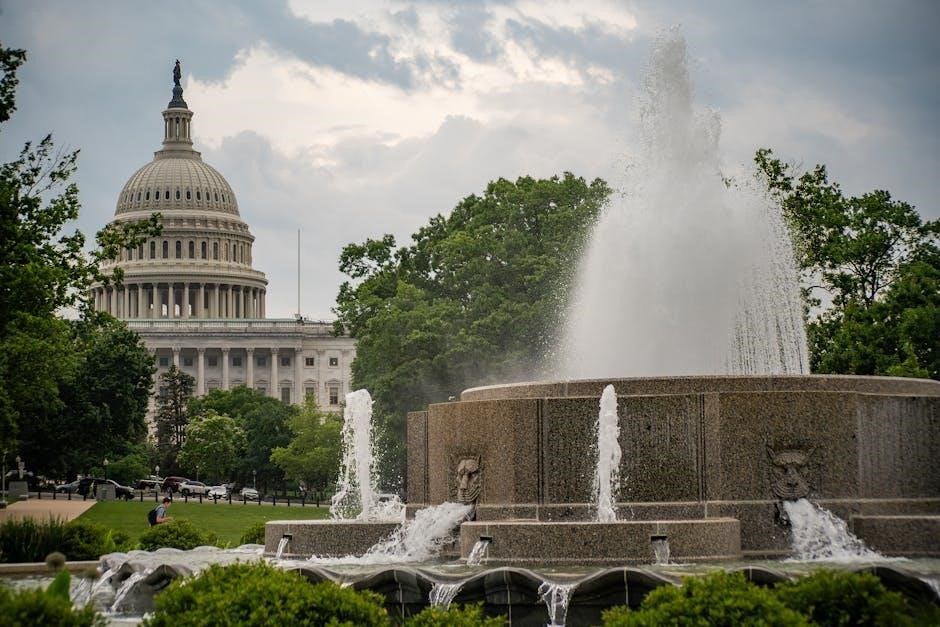
The Judicial Branch: The Supreme Court and Federal Courts
The judicial branch, headed by the Supreme Court, interprets laws and ensures they align with the Constitution. It consists of federal courts, with the Supreme Court at the apex, comprising nine justices appointed for life. These justices, nominated by the President and confirmed by the Senate, decide cases involving constitutional issues, federal laws, and disputes between states. The judicial branch plays a crucial role in resolving legal disputes, setting legal precedents, and upholding individual rights. Through landmark decisions, the Supreme Court shapes the legal framework of the nation. Its rulings impact policies, civil liberties, and the balance of power among government branches. The judiciary’s independence ensures impartial decision-making, maintaining the rule of law and protecting the principles of justice and equality.
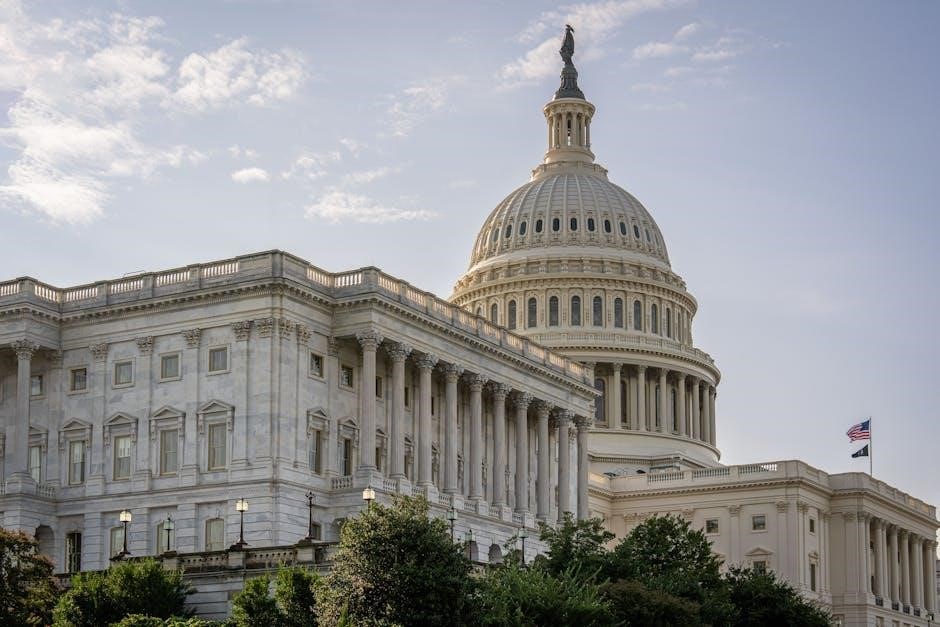
Political Participation
Political participation encompasses the ways citizens engage in the political process, including voting, joining parties, and advocating for policies. It strengthens democracy by ensuring public input shapes governance and holds elected officials accountable.
Voting Rights and Elections
Voting rights and elections are cornerstone elements of U.S. democracy, ensuring citizen participation in governance. The AMSCO guide explores the historical expansion of voting rights, from the 13th Amendment abolishing slavery to the 19th granting women the right to vote and the 26th lowering the voting age to 18. It highlights landmark legislation like the Voting Rights Act of 1965, which addressed racial discrimination in voting practices. The guide also examines the electoral process, including the Electoral College system, campaign finance, and the role of political parties in shaping elections. Key issues such as voter suppression, gerrymandering, and the impact of money in politics are discussed, emphasizing the ongoing challenges to ensuring equitable and representative elections. Understanding these concepts is vital for grasping how democracy functions in the U.S.
Political Parties and Their Roles
Political parties play a pivotal role in shaping the U.S. political landscape by organizing governance, elections, and policy debates. The AMSCO guide focuses on the two-party system, dominated by Democrats and Republicans, while also acknowledging the existence of third parties. It explains how political parties serve as coalitions of interests and ideologies, influencing public opinion and policy agendas. The guide highlights the functions of political parties, including candidate recruitment, fundraising, and campaigning. Additionally, it explores how parties operate within Congress, organizing legislative agendas and fostering unity among members. Understanding the roles of political parties is essential for grasping how power is distributed and exercised in American democracy, as well as how they reflect and shape societal divisions.
Interest Groups and Lobbying
Interest groups and lobbying are essential components of U.S. politics, enabling organized representation of diverse interests. The AMSCO guide explains how these groups influence public policy by advocating for specific causes or industries. Lobbying, a key tactic, involves direct communication with policymakers to shape legislation and regulations. Interest groups employ various strategies, including grassroots mobilization, campaign contributions, and legal action. They represent a wide range of sectors, from businesses and unions to environmental and social organizations. While these groups amplify voices in democracy, critics argue they often prioritize powerful interests over the public good. The guide emphasizes the balance between legitimate advocacy and potential undue influence, highlighting the need for transparency and ethical standards in lobbying practices. Understanding their roles is crucial for analyzing power dynamics in American governance.
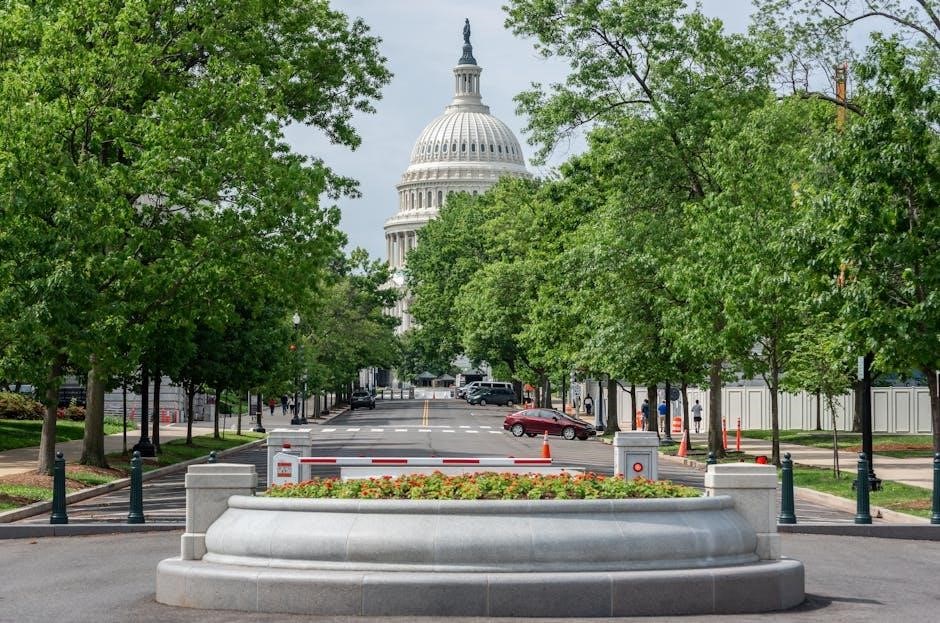
The Electoral Process
The Electoral Process is a critical component of U.S. democracy, detailing the mechanisms and rules governing elections, candidate selection, and voter participation. Understanding it is essential for engaging with American governance effectively.
The Electoral College System
The Electoral College System is a unique mechanism established by the U.S. Constitution to elect the President and Vice President. It assigns each state a certain number of electors based on its population, ensuring smaller states have a voice. Electors typically cast votes for the candidate who wins the popular vote in their state, though “faithless electors” occasionally deviate. Critics argue this system can lead to a candidate winning the presidency without the popular vote, sparking debates about representation and fairness. The AMSCO guide explores the historical rationale behind the Electoral College, its operational mechanics, and its controversial impact on modern elections, providing students with a nuanced understanding of this pivotal process.
Campaign Finance and Its Impact
Campaign finance plays a critical role in shaping U.S. elections, influencing candidate viability and policy outcomes. The AMSCO guide examines how money is raised, spent, and regulated in political campaigns. It highlights the impact of landmark Supreme Court decisions, such as Citizens United v. FEC, which allowed unlimited corporate and union spending through Super PACs. The guide explores the pros and cons of campaign finance laws, including disclosure requirements and the rise of dark money. It also discusses the potential for financial influence to undermine democracy and the ongoing debates over reform. Understanding campaign finance is essential for grasping how money shapes political power and accountability in the U.S. political system.
Media Influence on Elections
The media plays a pivotal role in shaping public perception and influencing election outcomes. The AMSCO guide explores how traditional and new media platforms frame political issues, set agendas, and sway voter opinions. It discusses the impact of 24-hour news cycles, social media, and misinformation on the electoral process. The guide also examines how media bias, whether perceived or real, can polarize the electorate and influence candidate credibility. Additionally, it highlights the challenges of disinformation campaigns and the importance of media literacy in maintaining a well-informed democracy. By analyzing these dynamics, the guide emphasizes the critical role of the media in both informing and potentially misguiding the public during elections.

Civil Rights and Liberties
Civil rights and liberties are foundational to U.S. democracy, ensuring protections against government overreach and promoting equality. The AMSCO guide examines these principles, their legal frameworks, and their evolution over time.
Key Supreme Court Cases on Civil Rights
The AMSCO guide delves into landmark Supreme Court cases that have shaped civil rights in the U.S., such as Brown v. Board of Education, Roe v. Wade, and Obergefell v. Hodges. These cases address racial segregation, reproductive rights, and LGBTQ+ marriage equality, respectively, showcasing the judiciary’s role in interpreting the Constitution. The guide explains how these rulings have influenced societal change and legal precedent, emphasizing their significance in the struggle for equality. By analyzing these cases, students gain insight into the evolving nature of civil rights and the Supreme Court’s impact on American society. This section is essential for understanding the legal frameworks that protect individual freedoms and promote justice.
Equal Protection and Due Process
The AMSCO guide explores the principles of Equal Protection and Due Process, fundamental to American law and civil liberties. Rooted in the 14th Amendment, Equal Protection ensures that no state denies individuals equal protection under the law, combating discrimination. Due Process guarantees fair treatment through the judicial system, safeguarding rights like notice, hearing, and impartial judgment. These principles are crucial in upholding justice and equality, shaping landmark rulings on civil rights, education, and criminal justice. The guide illustrates how these constitutional safeguards prevent arbitrary government actions and protect individual freedoms, emphasizing their importance in maintaining a just society. Understanding these concepts is vital for grasping the legal framework of U.S. governance and the protection of civil liberties.
Freedom of Speech and Religion
The AMSCO guide delves into the cornerstone of American liberties: Freedom of Speech and Religion, protected under the First Amendment. Freedom of Speech ensures individuals can express opinions without government restraint, fostering a vibrant democracy. The guide examines landmark Supreme Court cases, such as Tinker v. Des Moines, which upheld students’ rights to free expression. Similarly, Freedom of Religion encompasses both the Establishment Clause and the Free Exercise Clause, preventing government-imposed religion while safeguarding religious practices. Cases like Lemon v. Kurtzman and Oregon v. Smith illustrate the legal boundaries. These freedoms are essential to individual autonomy and societal pluralism, as explored in the guide.
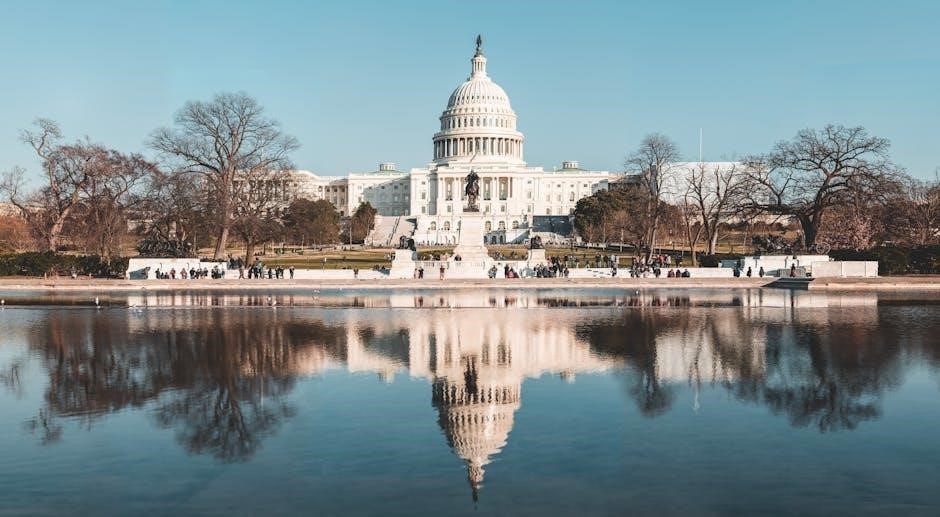
Public Policy and Governance
This section explores the role of government in shaping policies that address societal needs, economic stability, and public welfare, highlighting the balance between governance and individual freedoms.
Economic Policy and Government Intervention
Economic policy involves government actions to manage the economy, including fiscal and monetary strategies. Fiscal policy uses spending and taxation to influence economic activity, while monetary policy, controlled by the Federal Reserve, adjusts interest rates and money supply to stabilize the economy. Government intervention aims to address market failures, regulate industries, and achieve broader economic goals like full employment and price stability. Tools such as stimulus packages, subsidies, and regulations are employed to mitigate economic downturns and promote growth. This section examines the role of government in balancing free-market principles with necessary interventions to ensure economic stability and equity, highlighting both the benefits and potential drawbacks of such policies.
Social Policy and Welfare Programs

Social policy refers to government initiatives aimed at improving the welfare of citizens, addressing societal needs, and reducing inequality. Welfare programs, such as Social Security, Medicaid, and food assistance, provide financial and social support to vulnerable populations. These programs are designed to ensure basic needs like healthcare, education, and housing are met. Federal, state, and local governments collaborate to fund and implement these policies, often drawing from taxpayer revenues. Debates surrounding social policy often focus on balancing individual responsibility with government intervention, as well as the effectiveness and sustainability of welfare systems. Understanding these programs is crucial for evaluating their role in promoting social justice and addressing systemic challenges in American society.
Understanding U.S. government and politics is essential for active citizenship and informed decision-making. The AMSCO guide provides a clear, structured approach to mastering these critical subjects.
The Significance of Understanding U.S. Government and Politics
Understanding U.S. government and politics is crucial for fostering informed citizenship and civic engagement. It empowers individuals to critically analyze policies, participate in elections, and hold leaders accountable. By grasping foundational concepts like the Constitution, federalism, and civil liberties, citizens can navigate complex political landscapes and contribute meaningfully to public discourse. This knowledge also enhances critical thinking and problem-solving skills, enabling individuals to evaluate the impact of government decisions on society and the economy. Ultimately, studying U.S. government and politics equips citizens with the tools to advocate for their rights and shape the future of their communities and nation.
